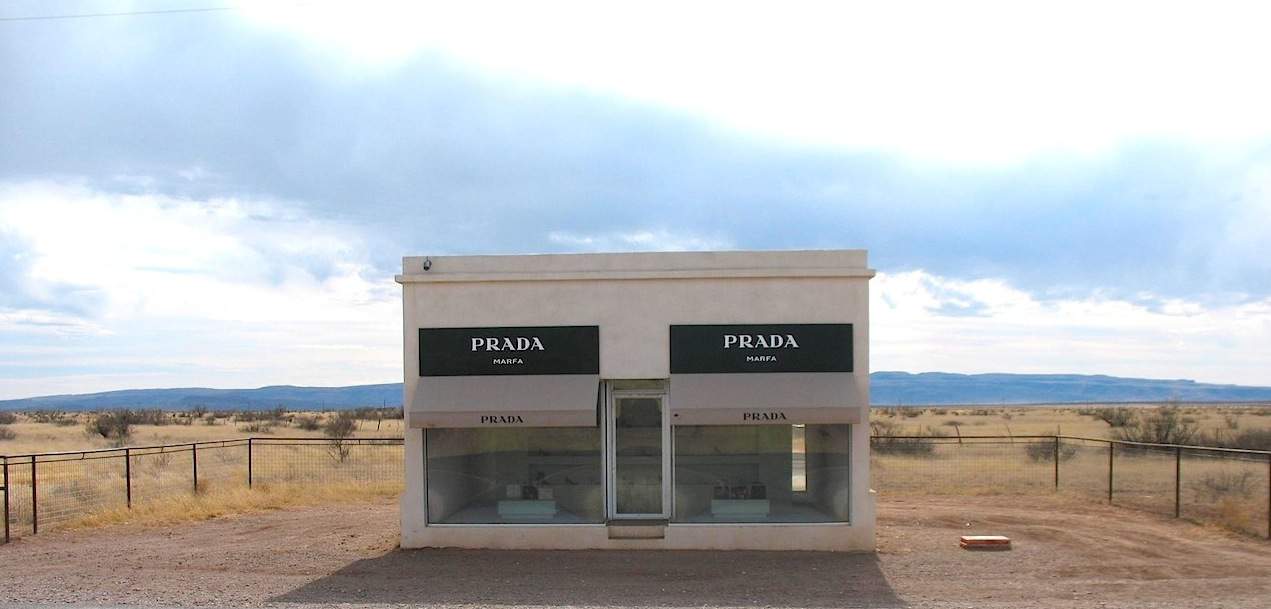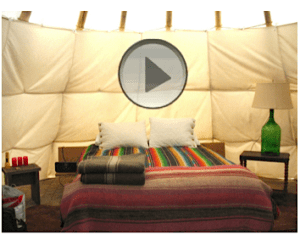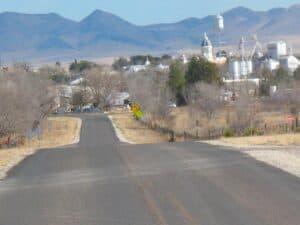
Remote and different, Marfa, TX began life as a water stop on the old steam railroad. Today it is truly out there.
Southwest Texas is vast, and mostly empty. From San Antonio to El Paso, a distance of 550 miles, no town larger than 9,000 people exists. In the entire region, an area about the size of California, the population does not exceed that of Rhode Island.
In the 1880s the region was even more uninhabited. Yet steam locomotives plying the railroad between San Antonio and El Paso needed to stop from time to time to replenish their water, so stops were established at remote outposts to serve that purpose. Around these water stops, small towns grew up.
One such stop was Marfa. The name came from a character in a Dostoevsky novel, if you believe some folks, from a character in a Jules Verne novel, if you believe others, but what is truly noteworthy is that the town was named after a character in a novel by a high minded author, which says something about the sort of people who founded Marfa. They were the sort of people who valued art, a quality that would distinguish Marfa throughout its history.
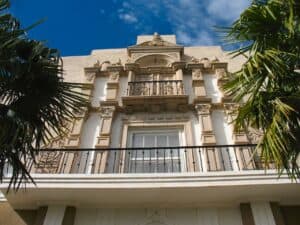
The lavish El Paisano Hotel designed by Henry C. Trost was built in anticipation of an oil boom that never happened.
A Handsome Jilted Suitor
In 1911 instability in nearby Mexico led to raids by Pancho Villa and other bandits into southwest Texas. In response the US military established Camp Albert at Marfa to police the region. Before long, the threat from Mexico died down, but six years later the United States entered World War I so the camp was expanded and renamed Camp Marfa.
After the war the camp was used as a military base to patrol the border for illegal aliens, but during the Depression it fell into disuse and was abandoned. Marfa was in danger of becoming a ghost town, except for one thing.
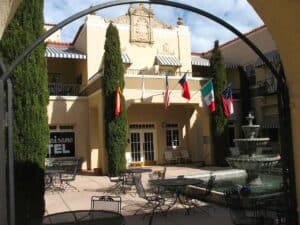
The showcase of the El Paisano is the Spanish Colonial courtyard reminiscent of 18th century Madrid or 1920’s Hollywood. But it’s in Marfa.
Just prior to the economic downturn in the final years of the roaring 20’s predictions of an impending oil boom led financiers to build a lavish hotel in Marfa. It was called the El Paisano Hotel, and it sat poised to service a gaggle of wealthy oil barons. In the event, however, the oil boom never materialized, and then the depression hit, and then the base closed. The El Paisano was a handsome suitor left jilted at the altar.
To design the hotel the financiers had hired one of the finest architects of the day, a man named Henry C. Trost. Trost designed the El Paisano in the Spanish Colonial Revival Style with Roman blind arcades, balconies, awnings and decorative iron trim. If Marfa was going to be a ghost town, it would be one with a gorgeous hotel at its center.
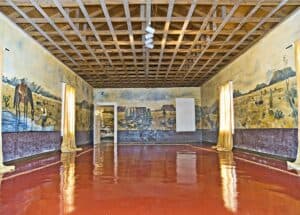
German prisoners of war left behind this colorful mural on the walls of the mess hall of Fort D.A. Russell when it closed at the end of World War II.
Visitors to Mafa today can still see the El Paisano. It’s still an operating hotel. Trost certainly did a nice job. The showpiece is the 50×50 foot Spanish colonial courtyard with a baroque fountain in its center. When you are in the courtyard, you could be in Madrid in the 18th century or in Hollywood in the 1920’s, and then you step outside and you are in a dusty Texas cow town far from anywhere. The dichotomy is striking. But then Marfa is full of striking dichotomies. Marfa is way, way out there in more ways than one.
The Happy, Painting Nazis
After briefly closing in the mid-1930’s the military camp at Marfa got a new lease on life in 1935 as the home of the 77th Field Artillery. It was renamed Fort D.A. Russell. In the run up to World War II it expanded, adding an airbase and a training facility for chemical mortar battalions.

After the war Fort D.A. Russell was closed down. Many of the buildings fell into ruin. Marfa entered a brief downturn.
During this time, no less a light than General George S. Patton passed through, a famously rigid, no-nonsense commander who nevertheless displayed a softer side as an amateur poet and sketch artist.
In 1942 Patton shipped off to North Africa for Operation Torch. A few months later Nazi prisoners of war began coming in. Fort D.A. Russell became a prisoner of war camp. At its height the base housed 200 German prisoners, many of them grateful to be tucked away in a place so far removed from the bloodshed. Some of them showed their appreciation by painting murals on the walls of the mess hall.
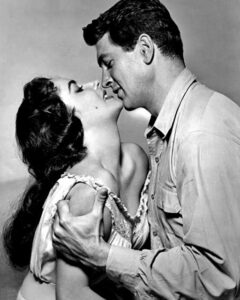
Giant depicts an iconic image of rural west Texas that resonates with people even today. It was filmed in and around Marfa.
After the German POW’s were sent home at the end of World War II the murals remained and can still be viewed today. Interestingly, they do not depict wistful visions of the German fatherland but colorful images of the American west. They became yet another piece in the growing cultural mosaic of Marfa.
After the war the base was closed and the town fell on hard times. Through the late 1940’s and early 50’s Marfa was largely the domain of cattle ranchers and miners from the nearby Chinati Mountains. Then in the late 1950’s two events occurred that put Marfa back on the map.
A Giant Comes to Marfa
In 1955 film crews arrived to shoot a George Stevens directed adaptation of the Edna Ferber novel Giant. The movie is an epic portrayal of a powerful Texas ranching family starring Elizabeth Taylor, James Dean and Rock Hudson.
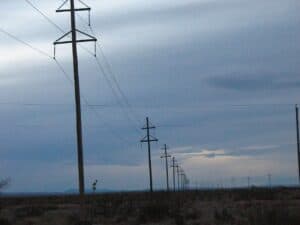
Telephone poles stand eerily against the dusk near the viewing platform for the Marfa Mystery Lights.
Giant depicts an iconic image of rural Texas that resonates with people even today. It was nominated for nine academy awards, taking away the prize for best director. More importantly for Marfa its stirring images of the Texas high desert sparked an interest in the town as a location for film shooting, adding to the town’s growing artistic resume.
A year later in 1957 an article appeared in Coronet Magazine covering a mysterious phenomenon in the desert outside Marfa, a set of strange lights that hovered and bounced on the distance horizon. This was the first published story of what came to be known as the Marfa Mystery Lights.
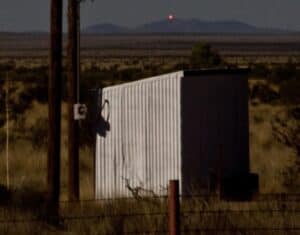
What the heck is that thing? A red light hovers over the distant mountains near Marfa, testing the willingness of onlookers to embrace a sense of mystery.
Today the lights can be seen from a viewing platform off Hwy 90 about nine miles east of Marfa. The platform itself is a fairly elaborate affair with telescopes, maps and explanatory placards as well as all the amenities to be found in a good interstate rest stop. The amount of time and money sunk into the platform suggests there must be more to the mystery than mere fantasizing, but then again it could just be an innocent effort to give the curious what they want, an easy way to embrace a sense of mystery.
The Marfa Mystery Lights
My brother and I stood shivering in the nighttime desert with a couple from Austin and another from the UK. It was just after sundown. Far away to the south we saw the lights.
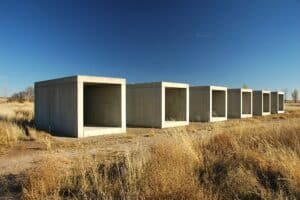
On the grounds of the former military base are 15 large concrete boxes. They are the work of Donald Judd, a groundbreaking New York artist who moved to Marfa in the 1970s.
They appeared as tiny balls of light strung out along the horizon. They glimmered and enlarged and then quickly winked out. It seemed pretty obvious they were automobile lights or warning lights from distant radio towers, but the couple from Austin assured us that no roads existed in that area and that there were no radio towers. What’s more, as the placards point out, the lights had been attested to by Apache Indians long before the invention of the automobile or the radio. We then engaged in one those interesting debates that occurs whenever people are confronted with fanciful explanations for the potentially mundane. We immediately began sorting ourselves into believers and nonbelievers.
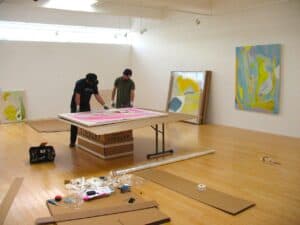
Two artists prepare for an opening at the Marfa Book Company. Marfa has 19 galleries displaying cutting edge contemporary art, a startling number for a town of less than 2,000.
The man from the UK dug in, refusing to be taken in, mildly insulted by the notion that the lights were anything mysterious at all. The woman from Austin, on the other hand, was positively ebullient at the possibility that the lights were an enigma. She kept bubbling up “There’s one!” and “There’s another one!” as if each new appearance was further evidence of the great mystery.
My brother and I were willing to let go of our skepticism and believe. Credulity has its own rewards. To believe is simply a willingness to embrace the better story, and in Marfa no one wants to stand in the way of a good story.
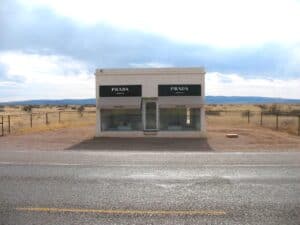
Prada Marfa. A Prada store in the middle of nowhere, a permanent art installation highlighting the whimsical dichotomy at the heart of Marfa.
The New York City of the High Desert
Outside the former gymnasium on the grounds of the old military base in Marfa are 15 large concrete boxes. To the uninformed they appear to be, well, 15 large concrete boxes, but to those willing to accept it they are groundbreaking pieces of minimalist art, the work of Donald Judd, a New York based artist who moved to Marfa in the 1970’s. Judd was looking for an escape from the frenetic New York art scene and in Marfa he found it, vast wide open spaces against which to juxtapose his stark geometric forms.
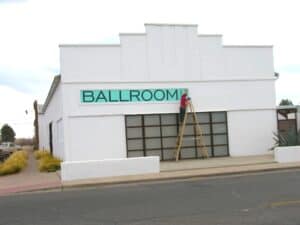
Ballroom Marfa. Over the years more and more galleries have cropped up in Marfa, in a former gas station, in a church, and in this former dance hall.
In 1979 he bought 340 acres of land in and around the former military base and established the Chinati Foundation, a non-profit art foundation dedicated to showcasing the works of abstract artists like Dan Flavin, John Chamberlain and Judd himself.
The appearance of these New York artists in Marfa in 1986 wrought a sea change in the town. Suddenly it became ultra hip to show in Marfa, and over the next 15 years more and more galleries cropped up. In a former gas station, in a converted dance hall, in storefronts and in a church, the galleries of Marfa today display some of the finest non-representational art in America. In a town with a single traffic light and a population of just over 2,000, there are 19 art galleries displaying fine art as well as performance, music and film.
Did the people of Marfa set out to lure these artists to their tiny desert town? No, but then neither did they discourage it. There is an artlessness to Marfa that is palpable, an easy going tolerance of the odd and outlandish that has attracted the sort of people more commonly seen in the hipster enclaves of New York or Chicago.
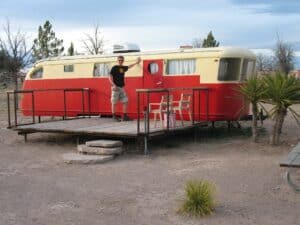
My brother Curt stands outside a 1950’s era mobile home, his lodging for the night at El Cosmico campground.
All the Best People Come to Marfa
The juxtaposition of urban hipsters with laconic cattle ranchers might not work in another town, but it works in Marfa, perhaps because from the beginning Marfa has shown a love for the arts. In addition to Henry C. Trost, George Stevens and Donald Judd the town has played host to film director Paul Thomas Anderson and actor Daniel Day Lewis who came here in 2006 to film There Will Be Blood. In the same year the Coen Brothers arrived to shoot No Country for Old Men, a movie based on the novel by Cormac McCarthy, which is set in the same region.
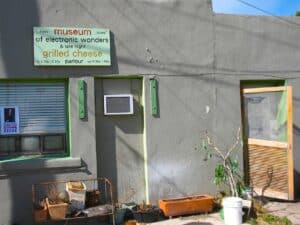
The Museum of Electronic Wonders. On Saturday nights a line forms outside this modest structure in anticipation of epic grilled cheese sandwiches.
For a town so tiny and remote Marfa has seen a startling array of great artists. Yet the town is remarkably free of pretension. There is an impish quality to Marfa, an amused wonder at its own incongruities that finds expression in a number of curious ways.
The Museum of Electronic Wonders and Late Night Grilled Cheese Parlour
As an awestruck hippie might say, “Marfa is cosmic, man.” That’s certainly the case with El Cosmico, an 18-acre trailer and teepee campground opened in 2009.
Conceived by a former hippie and designed by a team of artists and architects, El Cosmico offers a kooky take on rustic lodging. When you stay at El Cosmico you can choose from a fully furnished Native American teepee or one of seven vintage trailers from the 1950’s and 60’s. Staying here is like staying in a museum.
Speaking of museums, how about the Museum of Electronic Wonders & Late Night Grilled Cheese Parlour? This tiny one room establishment boasts a collection of bubble TVs, retro furniture and 8-track tapes which serves as the backdrop for a restaurant devoted to eccentric renditions of grilled cheese sandwiches. As the name implies it is only open late at night.
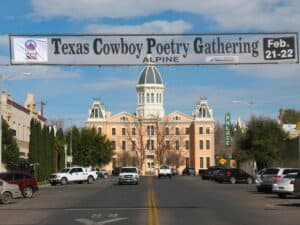
Always art. A sign hangs above the main street of Marfa announcing the annual Texas Cowboy Poetry Gathering. In and around Marfa something artistic is always happening.
But when it comes to the offbeat, nothing says Marfa quite like Prada Marfa. Far out in a remote stretch of uninhabited desert stands a perfect replica of a Prada store, for all the world as if it had been sucked through a time warp and deposited there. As an expression of the weird juxtaposition of the hip and the unassuming, the oddball and the everyday, this permanent art installation by the artists Elmgreen and Dragset speaks volumes about the dichotomy of Marfa, a town at once artful and artless, a true original.
With its love of incongruities, its passive nurturing of credulity and its appreciation for the arts, Marfa would be a unique place anywhere in the world, but to find such a place in the remote desert of southwest Texas is truly surprising. Marfa is many things at once, but one thing is beyond dispute. Marfa is way, way out there.
Previous stop on the odyssey: Austin, TX //
Next stop on the odyssey: Telluride, CO
Image credits:
All images and videos by Malcolm Logan, except Prisoners of war mural, John Chandler; Still from the film Giant, Public domain; Judd’s concrete boxes, Informedmindstravel; Mystery light, 12 Foot Hedgehog

